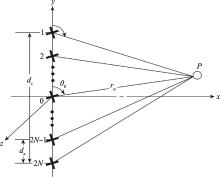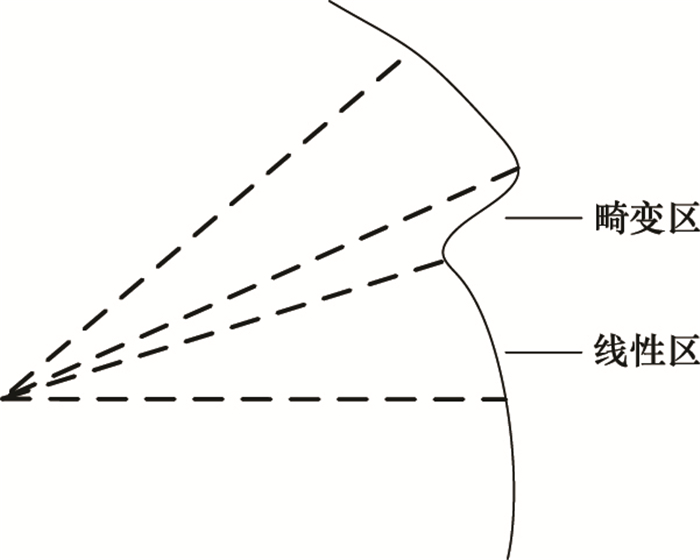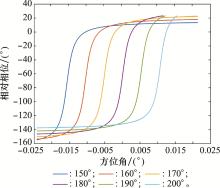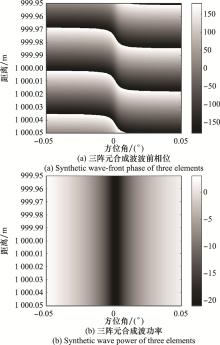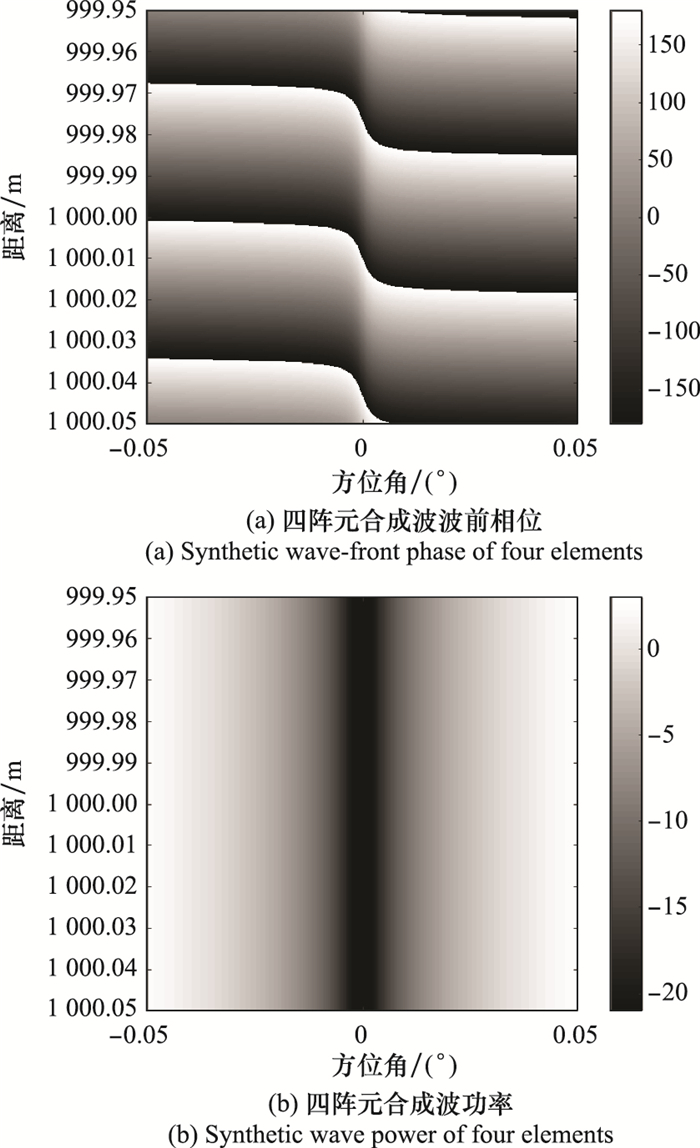Systems Engineering and Electronics ›› 2022, Vol. 44 ›› Issue (5): 1439-1446.doi: 10.12305/j.issn.1001-506X.2022.05.02
• Electronic Technology • Previous Articles Next Articles
Analysis on wave-front phase distortion characteristics based on NSGA-Ⅱ
Jiabei CHEN*, Qingping WANG, Yuan YE, Weiwei WU, Naichang YUAN
- The State Key Laboratory of Complex Electromagnetic Environment Effects on Electronics and Information System, National University of Defense Technology, Changsha 410000, China
-
Received:2021-05-28Online:2022-05-01Published:2022-05-16 -
Contact:Jiabei CHEN
CLC Number:
Cite this article
Jiabei CHEN, Qingping WANG, Yuan YE, Weiwei WU, Naichang YUAN. Analysis on wave-front phase distortion characteristics based on NSGA-Ⅱ[J]. Systems Engineering and Electronics, 2022, 44(5): 1439-1446.
share this article
| 1 | 刘天鹏. 多源反向交叉眼干扰技术研究[D]. 长沙: 国防科学技术大学, 2016. |
| LIU T P. Research on multi-source reverse cross eye interference technology[D]. Changsha: National University of Defense Technology, 2016. | |
| 2 | 刘松杨. 基于干扰平台旋转的反向交叉眼干扰研究[D]. 西安: 西安电子科技大学, 2016. |
| LIU S Y. Research on reverse cross eye interference based on interference platform rotation[D]. Xi'an: Xidian University, 2016. | |
| 3 | HOWARD D D. Radar target angular scintillation in tracking and guidance systems based on echo signal phase front distortion[C]//Proc. of the NEC, 1959: 840-849. |
| 4 | 刘芳, 陈嘉贝, 吕欢, 等. 新构型下多环路反向交叉眼干扰分析[J]. 电波科学学报, 2020, 35 (4): 164- 174. |
| LIU F , CHEN J B , LYU H , et al. Analysis of multi loop reverse cross eye interference under new configuration[J]. Chinese Journal of Radio Science, 2020, 35 (4): 164- 174. | |
| 5 | LIU W, MENG J, ZHOU L. Research on rectangular array retrodirective cross-eye jamming method considering target echo[C]//Proc. of the IEEE 19th International Conference on Communication Technology, 2019: 224-227. |
| 6 |
DU PLESSIS W P , ODENDAAL J W , JOUBERT J . Extended analysis of retrodirective cross-eye jamming[J]. IEEE Trans.on Antennas and Propagation, 2009, 57 (9): 2803- 2806.
doi: 10.1109/TAP.2009.2027353 |
| 7 |
ODENDAAL J W , JOUBERT J . Tolerance analysis of cross-eye jamming systems[J]. IEEE Trans.on Aerospace and Electronic Systems,, 2011, 47 (1): 740- 745.
doi: 10.1109/TAES.2011.5705705 |
| 8 |
PLESSIS W . Statistical skin-return results for retrodirective cross-eye jamming[J]. IEEE Trans.on Aerospace and Electronic Systems, 2019, 55 (5): 2581- 2591.
doi: 10.1109/TAES.2019.2930168 |
| 9 | 周亮, 孟进, 吴灏, 等. 考虑目标回波的两点源反向交叉眼干扰建模[J]. 电子与信息学报, 2019, 41 (4): 816- 821. |
| ZHOU L , MENG J , WU H , et al. Interference modeling of two point source retrodirective cross-eye considering target echo[J]. Journal of Electronics & Information Technology, 2019, 41 (4): 816- 821. | |
| 10 | 周亮, 孟进, 吴灏, 等. 反向交叉眼对单脉冲雷达干扰效果分析及仿真验证[J]. 航空学报, 2019, 40 (8): 151- 160. |
| ZHOU L , MENG J , WU H , et al. Analysis and simulation verification of retrodirective cross-eye against monopulse radar[J]. Acta Aeronautica et Astronautica Sinica, 2019, 40 (8): 151- 160. | |
| 11 | LIU T P, WEI X Z, LI L. Multiple-element retrodirective cross-eye jamming against amplitude-comparison monopulse radar[C]//Proc. of the 12th International Conference on Signal Processing, 2014: 2135-2140. |
| 12 | CHENG Y, LIU T P, HUO K, et al. Analysis of performance of shipborne cross-eye jamming against anti-ship missile[C]//Proc. of the Photonics & Electromagnetics Research Symposium-Fall, 2019: 2763-2769. |
| 13 |
LIU T P , WEI X Z , PENG B , et al. Tolerance analysis of multiple-element linear retrodirective cross-eye jamming[J]. Journal of Systems Engineering and Electronics, 2020, 31 (3): 460- 469.
doi: 10.23919/JSEE.2020.000028 |
| 14 |
LIU S Y , DONG C X , XU J , et al. Analysis of rotating cross-eye jamming[J]. IEEE Antennas and Wireless Propagation Letters, 2015, 14, 939- 942.
doi: 10.1109/LAWP.2014.2387423 |
| 15 | SONG Z Y, LI G Q, FU Q. Principle analysis of coherent two-point source jamming based on amplitude comparison monopulse[C]//Proc. of the 3rd International Conference on Electronic Information Technology and Computer Engineering, 2019: 919-923. |
| 16 |
LIU W , MENG J , ZHOU L . Method of four-element retrodirective cross-eye jamming based on DOA[J]. IEEE Access, 2020, 8, 76896- 76902.
doi: 10.1109/ACCESS.2020.2990906 |
| 17 | MA J Z, SHI L F, CUI G, et al. Further analysis of retrodirective cross-eye jamming: polarization considerations[C]//Proc. of the 12th European Conference on Antennas and Propagation, 2018. |
| 18 |
MA J Z , SHI L F , XIAO S P , et al. Mitigation of cross-eye jamming using a dual-polarization array[J]. Journal of Systems Engineering and Electronics, 2018, 29 (3): 491- 498.
doi: 10.21629/JSEE.2018.03.06 |
| 19 | DU PLESSIS W P . Path-length effects in multiloop retrodirective cross-eye jamming[J]. IEEE Antennas and Wireless Pro-pagation Letters, 2015, 15, 626- 629. |
| 20 |
DU PLESSIS W P . Analysis of path-length effects in multiloop cross-eye jamming[J]. IEEE Trans.on Aerospace and Electronic Systems, 2017, 53 (5): 2266- 2276.
doi: 10.1109/TAES.2017.2690538 |
| 21 | DU PLESSIS W P . Path-length compensation in multiloop retrodirective cross-eye jamming[J]. IEEE Trans.on Aerospace and Electronic Systems, 2018, 55 (1): 397- 406. |
| 22 | PIETERSE F, DU P W P. Retrodirective cross-eye jammer implementation using software-defined radio (SDR)[C]//Proc. of the IEEE Radar Conference, 2021. |
| 23 | KALINBACAK I, PEHLIVAN M, YEGIN K. Cross-eye monopulse jammer located on UAV[C]//Proc. of the Progress in Electromagnetics Research Symposium-Spring, 2017: 2032-2035. |
| 24 | SCHLEHER D C . Electronic warfare in the information age[M]. Boston: Artech House, 1999. |
| 25 | ADAMY D L . EW 101: a first course in electronic warfare[M]. Boston: Artech House, 2001. |
| 26 | NERI F . Introduction to electronic defense systems[M]. Boston: Artech House, 2006. |
| 27 |
YANG D G , LIANG B G , ZHAO D J . Cross-eye gain distribution of multiple-element retrodirective cross-eye jamming[J]. Journal of Systems Engineering and Electronics, 2018, 29 (6): 1170- 1179.
doi: 10.21629/JSEE.2018.06.06 |
| 28 | HARWOOD N M , DAWBER W N , KING D J , et al. Multiple-element cross-eye[J]. IET Radar, Sonar & Navigation, 2007, 1 (1): 67- 73. |
| 29 | 殷红成, 王超, 黄培康. 雷达目标角闪烁三种表示的内在联系[J]. 雷达学报, 2014, 3 (2): 119- 128. |
| YIN H C , WANG C , HUANG P K . Inherent relations among the three representations of radar target angular glint[J]. Journal of Radars, 2014, 3 (2): 119- 128. | |
| 30 | 殷红成, 黄培康, 王超. 再论扩展目标的角闪烁[J]. 系统工程与电子技术, 2007, 29 (4): 499- 504. |
| YIN H C , HUANG P K , WANG C . Re-discussion about angular glint of the extended target[J]. Systems Engineering and Electronics, 2007, 29 (4): 499- 504. | |
| 31 | 王国伟, 王红卫, 张曦. 多环路交叉眼干扰的波前相位畸变研究[J]. 信号处理, 2018, 34 (10): 1188- 1196. |
| WANG G W , WANG H W , ZHANG X . Study on wave-front phase distortion of multi-loop cross-eye jamming[J]. Journal of Signal Processing, 2018, 34 (10): 1188- 1196. | |
| 32 | 余忠卿. 无人机平台多元矢量辐射源建模及空间电磁场分析[D]. 成都: 电子科技大学, 2019. |
| YU Z Q. Modeling and space electromagnetic field analysis of multi vector radiation source for UAV platform[D]. Chengdu: University of Electronic Science and Technology of China, 2019. | |
| 33 | 成继隆, 胡东. 引入平台回波的相干两点源干扰技术研究[J]. 信息化研究, 2011, 37 (4): 25- 27. |
| CHENG J L , HU D . Research of coherent dual-sources jamming technique considering platform echo[J]. Electronic Engineer, 2011, 37 (4): 25- 27. |
| [1] | Fuhai WAN, Jingwei XU, Zhenrong ZHANG. Robust anti-main lobe range deceptive jamming technology with FDA-MIMO radar [J]. Systems Engineering and Electronics, 2022, 44(9): 2809-2816. |
| [2] | Penghui JI, Dahai DAI, Shiqi XING, Dejun FENG. Dense false moving targets generation method [J]. Systems Engineering and Electronics, 2022, 44(5): 1502-1511. |
| [3] | Yanfang HU, Baixiao CHEN, Chuanzhang WU. Anti-cross-eye jamming method based on monopulse radar 3-D imaging [J]. Systems Engineering and Electronics, 2022, 44(4): 1188-1194. |
| [4] | Luda ZHAO, Bin WANG. Method of electronic countermeasure targets' list generation based on RS-DBN [J]. Systems Engineering and Electronics, 2021, 43(9): 2373-2382. |
| [5] | Wenbo GUO, Changqing SONG, Yidan ZHANG, Hongzhi ZHAO, Shihai SHAO, Youxi TANG. Experimental testbed of self-interference suppression in electromagnetic spectrum umbrella [J]. Systems Engineering and Electronics, 2021, 43(9): 2637-2641. |
| [6] | Yuming JIANG, Jingwen LI, Bing SUN. DPCA method for detection and suppression of monostatic direct-wave deceptive jamming [J]. Systems Engineering and Electronics, 2021, 43(6): 1524-1532. |
| [7] | Xiaozhou CHEN, Qingjun XING, Lidong ZHANG. Slow-time-frequency-modulation jamming method forSTAP airborne early-warning radar [J]. Systems Engineering and Electronics, 2021, 43(11): 3177-3184. |
| [8] | Xia GAO, Yinghui QUAN, Yachao LI, Shengqi ZHU, Mengdao XING. Main-lobe deceptive jamming suppression with FDA-MIMO radar based on BSS [J]. Systems Engineering and Electronics, 2020, 42(9): 1927-1934. |
| [9] | Bokai ZHANG, Weigang ZHU. Construction and key technologies of cognitive jamming decision-making system against MFR [J]. Systems Engineering and Electronics, 2020, 42(9): 1969-1975. |
| [10] | Bokai ZHANG, Weigang ZHU. DQN based decision-making method of cognitive jamming against multifunctional radar [J]. Systems Engineering and Electronics, 2020, 42(4): 819-825. |
| [11] | NIU Liqiang, XIE Yongjun, ZHANG Chungang, WU Dongwei. Detection simulation of AEGIS combat system for ballistic missile in electronic warfare environment [J]. Systems Engineering and Electronics, 2019, 41(6): 1195-1201. |
| [12] | XING Qiang, ZHU Weigang, JIA Xin, ZHENG Guangyong. Jamming decision under condition of unknown jamming rule base [J]. Systems Engineering and Electronics, 2019, 41(2): 298-303. |
| [13] | LAN Lan, LIAO Guisheng, XU Jingwei, ZHANG Yuhong. Main-beam range deceptive jamming suppression approach with FDA-MIMO radar [J]. Systems Engineering and Electronics, 2018, 40(5): 997-1003. |
| [14] | HUANG Yong, DUAN Rui, ZHANG Hai, YAN Guangyu. Signal synthetic method of polarized deceptive jamming for spatial micro-motion targets [J]. Systems Engineering and Electronics, 2017, 39(8): 1738-1743. |
| [15] | WANG Caiyun, HE Zhiyong, GONG Jun. Analysis of retro-directive cross-eye jamming for multiple elements [J]. Systems Engineering and Electronics, 2017, 39(7): 1457-1463. |
| Viewed | ||||||
|
Full text |
|
|||||
|
Abstract |
|
|||||
